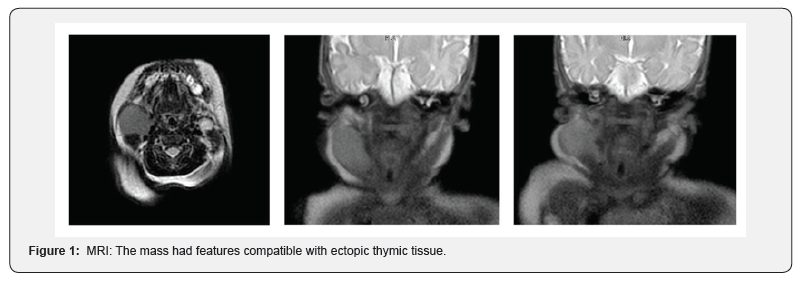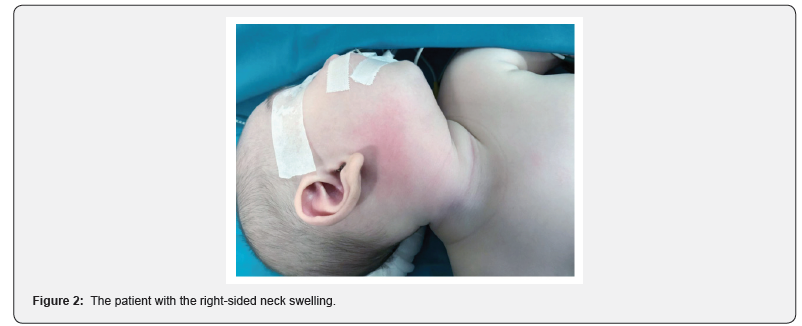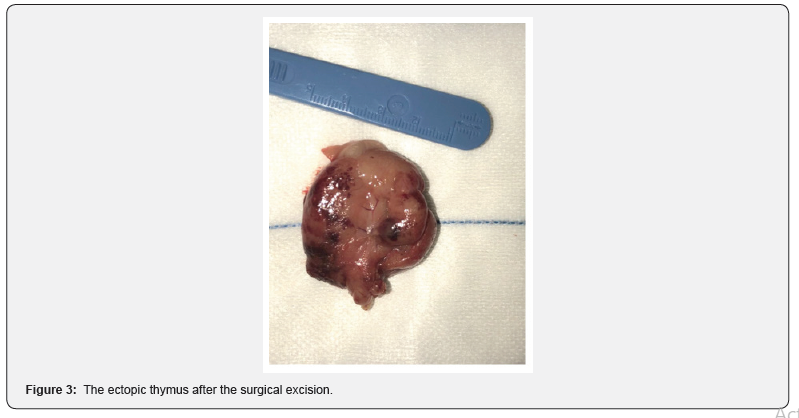Pediatrics & Neonatology - Juniper Publishers
Case Report
The aim of this paper is to report an unusual case
of ectopic cervical thymus (CET) in a one-month-old infant and to
underline the importance of considering it in the differential diagnosis
of neck masses in children. A one-month-old male infant was referred to
our Emergency Department for evaluation of a right-sided neck swelling,
which was noted by his parents about 2 days before. The mother’s
pregnancy (medically assisted procreation) was full term and
uncomplicated. The patient had never required admission to the hospital
or surgery. Family history was negative for thyroid disease and
malignancy. On physical examination, his height and weight were normal
in his peers. Vital signs were normal. The cervical mass was soft,
mobile, painless, and 4×3-cm rounded, in the right submandibular region
without a palpable margin. No overlying skin changes, or pits were
evident. No palpable cervical lymph nodes and history of difficulty in
feeding, breathing, and crying were present. Past medical history was
unremarkable and without a history of radiation exposure. His thyroid
gland was not enlarged.
Bio humoral work up included full blood count,
electrolytes, tumour markers (aFP, bHCG, CEA, Ca 19-9), thyroid
function, inflammatory parameters; we did also the immunological exams
(lymphocyte and NK population, Ig G, Ig A, Ig M count, vanilmandelic
acid and T cell receptor excision circles); all values resulted within
range whereas ultrasonography
revealed a nonhomogeneous, mainly cystic structure. On magnetic
resonance imaging (MRI) examination (Figure 1), a homogenous mass was
identified. The mass was 4 x 3cm in diameter, slightly hyperintense on
T1-weighted images and was markedly hyperintense on T2-weighted images.
The signal characteristics reflected that of the normal-appearing thymus
gland in the right upper mediastinum. The lesion determined moderate
compression of adjacent structures, particularly the parotid gland
behind. The mass had features compatible with ectopic thymic tissue.
Initially, agree with onco-haematologists and radiologists, we decided
to wait and to follow up the baby clinically and with an ultrasound
after two and four weeks. During the second check, we noticed that the
mass slightly grew up and at the ultrasound the dimensions were
increased. Therefore, after careful preparations, at the age of 3
months, the patient underwent a complete excision of the mass under
general anesthesia (Figure 2). We used routine cervical approach, and
found the mass was soft, yellow white (Fig. 3), with clear margins and
located in the carotid triangular area, posterior to the
sternocleidomastoid, deeper to it are arteria carotis communis, carotid
artery bifurcation and jugular vein. The postoperative course was
unremarkable, and the wound healed well. The patient was discharged on
the 6th postoperative day. The final histopathological report confirmed
the diagnosis of ectopic thymus.



Brief Discussion
Ectopic thymic tissue may be placed anywhere along the cervical
pathway of the thymopharyngeal duct [1] from the mandible
angle to the manubrium of the sternum. These migrational anomalies
may represent an unusual cause of pediatric neck lump but
it is rarely considered in the differential diagnosis of neck swellings.
To date, the real incidence of CET is still unknown yet; to our
knowledge, there are not more than 130 cases reported till now,
with about 10% occurring in infants [1]; it has unusually been reported
preoperatively in the literature, in fact it is generally identified
incidentally at autopsy or postoperative pathologic examination.
Histologically, an ectopic thymus can either be cystic or solid.
Nowak et al. [2] reviewed 91 cases of CET: 65 cases were cystic
forms, more common than the solid forms (26 cases). They also
reported that CET usually occurs between the ages of 2 and 13
years. In a review of 46 CET cases, 39 (85%) were male, and in 22
(56%) of these, the mass was detected on the right side [3].
The
most frequently presenting symptom is painless swelling. Other
symptoms, such as stridor, dyspnea, and/or dysphagia caused
by compression of the trachea and/or oesophagus, may occur in
10% of cases [4]. The thymus is a specialized organ in the immune
system: its functions are the “teaching” of T-lymphocytes and the
production and excretion of thymosin’s and hormones [5]. In patients
with a CET, only half or less of the organ can be present in
the chest, particularly on the side of the mass: presurgical recognising
of existence of normal mediastinal thymus is imperative to
avoid over-investigation, or biopsy/surgery with unintended total
thymectomy, and subsequent immunodeficiency, specifically in
infants and children. The clear preoperative diagnosis of CET is
difficult and hardly made preoperatively. In almost all reviewed
children, definitive diagnosis has relied on histopathologic examination
after surgery [5]. CET is usually misdiagnosed as cystic
hygroma, cystic teratoma, lymphoproliferative disorders, reactive
adenopathy, and vascular tumours [1]. MRI can help as in the diagnosis
of CET, determining if the mass’s density is similar to that
of normal thymus, as to demonstrate the presence of a mediastinal
thymus. Fine-needle biopsy combined with flow cytometry
analysis have been used in the pediatric population [1,6]. But the
sensitivity and specificity for fine-needle biopsy of thymic tissue
are not known in the children.
The natural history of the CET is unknown. Nearly all cases
reported in the literature have been surgically removed. Schloegel
and Gottschall [7] proposed a clinical algorithm for the management
of CET and suggested that “wait and watch” is the ideal
choice for these patients. But due to the lack of reports demonstrating
that CET would atrophy after puberty, we consider that
pathological examination at the moment is still the definite method
of diagnosis. In view of this, we advise that excision is a good
option for CET, not only to obtain pathology specimens but also to
correct facial asymmetry and avoid clinical symptoms. The best
age above which safe removal of the thymus can be performed has
not been determined. Accordingly, an accurate evaluation of thepresence of the normal mediastinal thymus should be undertaken
prior to removal of an ectopic cervical thymus, especially in children
younger than one year of age, to prevent the risk of immunocompromised
[8-10]. For our patient, we chose to conduct the
total excision of the lesion based on what previously declared, but
also because of the growth speed of the mass, which was rather
rapid. Moreover, in our department, this kind of neck tumour was
usually resected, and other conservative management methods
were not generally practiced. To conclude, ectopic cervical location
of the thymus is a very rarely diagnosed developmental disorder
in children. Our case highlights the role of histopathology
to confirm the correct diagnosis, the importance of investigating
the mediastinal thymus and immunology status before surgery.
Although difficult to differentiate from other conditions, it is important
for clinicians to be aware of its rarity and it has to be considered
in the differential diagnosis of unilateral solid–cystic neck
mass in pediatric age.r fine-needle biopsy of thymic tissue
are not known in the children.
Learning Points
1. Ectopic cervical thymus must be considered in the differential
diagnosis of unilateral neck masses in children.
2. Before surgery, it is mandatory to scan the presence of a
mediastinal thymus to avoid a total thymectomy; the best radiological
exam to demonstrate it is the MRI.Consider, before surgery, to make all immunology tests.
3. Consider, before surgery, to make all immunology tests.
To Know more about Pediatrics & Neonatology
Click here: https://juniperpublishers.com/ajpn/index.php
To Know more about our Juniper Publishers
Click here: https://juniperpublishers.com/index.php





No comments:
Post a Comment